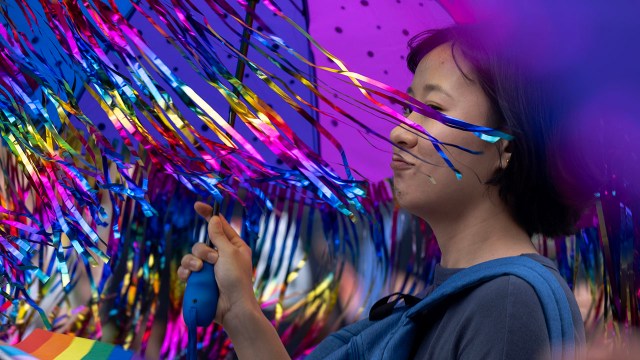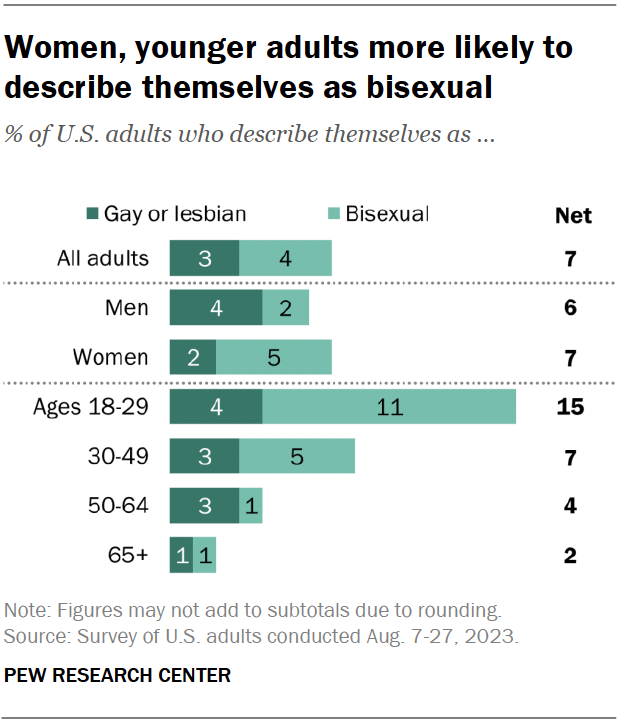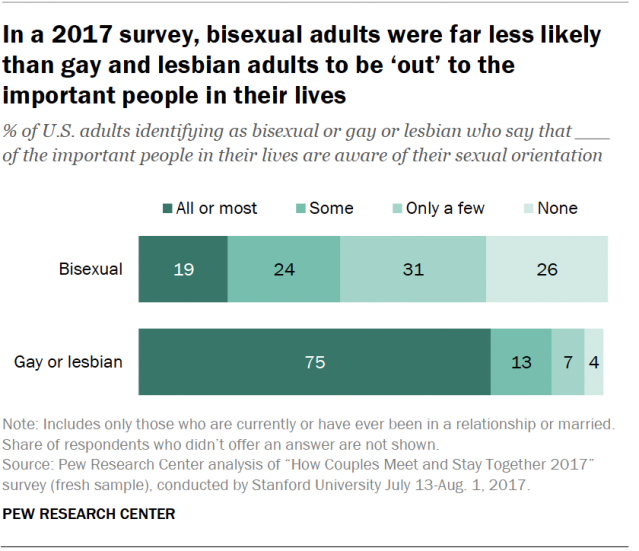
In June every year, Americans celebrate LGBTQ+ Pride Month, marking the anniversary of the Stonewall Uprising of 1969 – a series of encounters between police and LGBTQ+ protesters in New York City.
Pew Research Center previously has explored topics including the experiences and views of lesbian, gay, bisexual and transgender Americans and transgender and nonbinary Americans. The Center has also studied public attitudes about same-sex marriage in the United States. This analysis highlights key facts about the largest group among those who identify as LGBTQ+: bisexual Americans.
Pew Research Center published this analysis to provide an overview of findings about bisexual Americans. This overview is based on data from Center surveys and analyses conducted from 2019 to 2023, including a 2019 analysis of 2017 survey data from Stanford University and a 2023 analysis of lesbian, gay, bisexual and transgender lawmakers in Congress. More information about the Center studies cited in the analysis, including the questions asked and their methodologies, can be found at the links in the text.
This main data source for this analysis is a Center survey of 11,945 U.S. adults conducted from Aug. 7 to 27, 2023. Everyone who completed the survey is a member of the Center’s American Trends Panel (ATP), an online survey panel that is recruited through national, random sampling of residential addresses. This way nearly all U.S. adults have a chance of selection. The survey is weighted to be representative of the U.S. adult population by gender, race, ethnicity, partisan affiliation, education and other categories. Read more about the ATP’s methodology.
Here is the methodology used for this analysis.

Overall, 4% of U.S. adults say they identify as bisexual, according to an August 2023 survey by the Center. A similar share (3%) say they identify as gay or lesbian.
Among adults who are lesbian, gay or bisexual, meanwhile, bisexual Americans are the largest group, accounting for 60% of the total. (This survey did not ask respondents if they were transgender, so transgender adults are not included in this group. Other Center research has estimated the share of Americans who are transgender or nonbinary.)
The challenges of measuring LGBTQ+ identity
Survey researchers face several challenges in measuring LGBTQ+ identity. One is that there is no consensus about how best to measure sexual orientation. Some researchers rely on respondents self-identifying as LGBTQ+ (the technique used in surveys from Pew Research Center and Gallup), while others base their estimates on reports of sexual behavior or sexual attraction, which usually results in higher estimates. Other challenges include the stigmatization of identifying as LGBTQ+ in some cultures and respondents being unfamiliar with the terms used in surveys.
Women are more likely than men to say they identify as bisexual. Among women in the U.S., 5% identify as bisexual, compared with 2% of men. In turn, men are more likely than women to identify as gay or lesbian (4% vs. 2%), according to the same August 2023 survey. (There was not a large enough sample size to look at those who do not describe themselves as either a man or a woman.)
Younger adults are more likely than older Americans to describe themselves as bisexual. Some 11% of U.S. adults under 30 identify as bisexual, the August 2023 survey finds. This is far more than the 5% of adults ages 30 to 49 and the 1% of adults ages 50 and older who say the same.
Gender differences in bisexual identification persist even among the youngest adults. Among adults under 30, 16% of women and 5% of men identify as bisexual.
Roughly a third of bisexual adults (36%) are parents of children of any age. This is about half as many as the share of straight Americans who are parents (63%). Among gay or lesbian Americans, 22% are parents, according to the August 2023 survey. (This may reflect the fact that most bisexual adults who are married or living with a partner have a partner of the opposite gender.)
Bisexual people are less likely than gay or lesbian Americans to be “out” to the important people in their lives. In a 2019 Center analysis of data from a 2017 Stanford University survey, we found that only 19% of those who identify as bisexual say all or most of the important people in their lives are aware of their sexual orientation.

By comparison, three-quarters of gay or lesbian adults said the same. In fact, 26% of bisexual adults said they are not “out” to any of the important people in their lives, compared with a much smaller share of gay or lesbian adults (4%). Previous Center research has also found that bisexual adults have different experiences from gay and lesbian adults during or after coming out.
While bisexual adults make up the largest share of LGBTQ+ Americans, very few are represented in the U.S. Congress. Only one member of the current 118th Congress is openly bisexual: independent Sen. Kyrsten Sinema of Arizona, who’s leaving the Senate this year. Twelve lawmakers are openly gay or lesbian, bringing the total number of lesbian, gay or bisexual members of Congress to 13. They accounted for about 2% of the 534 voting lawmakers as of Jan. 3, 2023. There are no members of Congress who are openly transgender or nonbinary.
